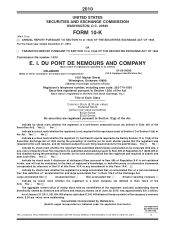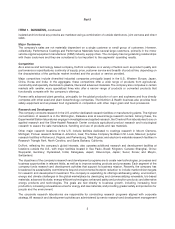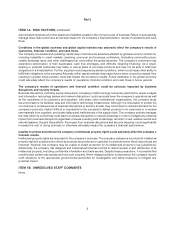DuPont 2010 Annual Report Download - page 8
Download and view the complete annual report
Please find page 8 of the 2010 DuPont annual report below. You can navigate through the pages in the report by either clicking on the pages listed below, or by using the keyword search tool below to find specific information within the annual report.Part I
ITEM 1A. RISK FACTORS, continued
volatility. When possible, the company purchases raw materials through negotiated long-term contracts to minimize
the impact of price fluctuations. Additionally, the company enters into over-the-counter and exchange traded derivative
commodity instruments to hedge its exposure to price fluctuations on certain raw material purchases. The company
takes actions to offset the effects of higher energy and raw material costs through selling price increases, productivity
improvements and cost reduction programs. Success in offsetting higher raw material costs with price increases is
largely influenced by competitive and economic conditions and could vary significantly depending on the market
served. If the company is not able to fully offset the effects of higher energy and raw material costs, it could have a
significant impact on the company’s financial results.
Failure to develop and market new products and manage product life cycles could impact the company’s
competitive position and have an adverse effect on the company’s financial results.
Operating results are largely dependent on the company’s assessment and management of its portfolio of current, new
and developing products and services and its ability to bring those products and services to market. The company
plans to grow earnings by focusing on developing markets and solutions to meet increasing demand for food
productivity, decrease dependency on fossil fuels and protect people, assets and the environment. This ability could be
adversely affected by difficulties or delays in product development such as the inability to identify viable new products,
successfully complete research and development, obtain relevant regulatory approvals, obtain intellectual property
protection, or gain market acceptance of new products and services. Because of the lengthy development process,
technological challenges and intense competition, there can be no assurance that any of the products the company is
currently developing, or could begin to develop in the future, will achieve substantial commercial success. Sales of the
company’s new products could replace sales of some of its current products, offsetting the benefit of even a successful
product introduction.
The company’s results of operations could be adversely affected by litigation and other commitments and
contingencies.
The company faces risks arising from various unasserted and asserted litigation matters, including, but not limited to,
product liability, patent infringement, antitrust claims, and claims for third party property damage or personal injury
stemming from alleged environmental torts. The company has noted a nationwide trend in purported class actions
against chemical manufacturers generally seeking relief such as medical monitoring, property damages, off-site
remediation and punitive damages arising from alleged environmental torts without claiming present personal injuries.
The company also has noted a trend in public and private nuisance suits being filed on behalf of states, counties, cities
and utilities alleging harm to the general public. Various factors or developments can lead to changes in current
estimates of liabilities such as a final adverse judgment, significant settlement or changes in applicable law. A future
adverse ruling or unfavorable development could result in future charges that could have a material adverse effect on
the company. An adverse outcome in any one or more of these matters could be material to the company’s financial
results.
In the ordinary course of business, the company may make certain commitments, including representations,
warranties and indemnities relating to current and past operations, including those related to divested businesses and
issue guarantees of third party obligations. If the company were required to make payments as a result, they could
exceed the amounts accrued, thereby adversely affecting the company’s results of operations.
The company’s business, including its results of operations and reputation, could be adversely affected by
process safety and product stewardship issues.
Failure to appropriately manage safety, human health, product liability and environmental risks associated with the
company’s products, product life cycles and production processes could adversely impact employees, communities,
stakeholders, the company’s reputation and its results of operations. Public perception of the risks associated with the
company’s products and production processes could impact product acceptance and influence the regulatory
environment in which the company operates. While the company has procedures and controls to manage process
safety risks, issues could be created by events outside of its control including natural disasters, severe weather events
and acts of sabotage.
7





















